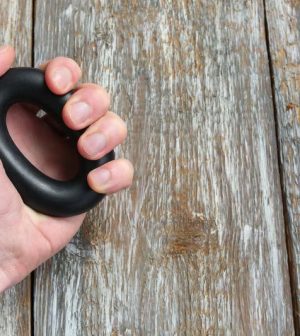- Skip Storing This Everyday Product in the Fridge Door
- Green Tea + B3 Pairing May Boost Brain Health
- Navigating Your Midlife Crisis: Embracing New Possibilities
- City Raccoons Showing Signs of Domestication
- Mapping the Exposome: Science Broadens Focus to Environmental Disease Triggers
- One Week Less on Social Media Linked to Better Mental Health
- Your Brain Changes in Stages as You Age, Study Finds
- Some Suicide Victims Show No Typical Warning Signs, Study Finds
- ByHeart Formula Faces Lawsuits After Babies Sickened With Botulism
- Switch to Vegan Diet Could Cut Your Greenhouse Gas Emissions in Half
Stroke Can Leave Folks Thinking One Hand Is Bigger Than the Other

Imagine living day-to-day with one hand that feels like it’s a baseball mitt, or another that feels like a small clutching claw.
That’s the experience of many stroke survivors who suffer from chronic pain, according to a new study in the journal Brain Sciences.
Stroke survivors living with chronic pain are almost three times as likely as pain-free survivors to experience altered body perception, researchers found.
Specifically, their pain-afflicted brain tricks them into believing that a stroke-affected hand is either bigger or smaller than it actually is, results showed.
“These remarkable findings show us that we are perhaps more complex creatures than we previously thought,” study co-author Lorimer Moseley, an international pain expert with the University of South Australia, said in a university news release.
Chronic pain previously has been shown to alter the way people perceive their own bodies, researchers said in background notes.
Body perception is formed by our brain combining different sensory inputs, and can be changed by one’s memories, beliefs, attitudes and perceptions, researchers said.
Moseley and his colleagues surveyed 523 stroke survivors to see how their condition might affect how they perceive their bodies.
They found that more than 3 out of 5 stroke survivors are living with chronic pain, “which is up to 300% higher than in the general population,” Moseley said.
Those in chronic pain were more likely to perceive major changes in how their body feels to them, the researchers also found.
“This is a potential double whammy, making daily activities more difficult and affecting quality of life,” Moseley said.
Results showed that stroke patients in chronic pain were about 2.9 times more likely to perceive one hand as being a different size, compared to those not suffering pain.
Further, those in chronic pain whose pain included the hand were nearly twice as likely to perceive altered hand size as those whose pain did not include the hand, the study found.
This is consistent with people who suffer chronic pain for reasons other than stroke, researchers said. For example, up to 30% of people with knee arthritis might believe their knee is swollen when it actually isn’t.
These sort of body misperceptions aren’t just an oddity, but can affect a person’s health by leading them to not use the affected body part, said Dr. Preeti Raghavan, director of recovery and rehabilitation with the Johns Hopkins Sheikh Khalifa Stroke Institute in Baltimore.
“One of the biggest problems we have with stroke patients as well as with patients with pain, if you are not able to move your arm as well because it doesn’t feel the same, you tend not to use the arm,” she said.
“That non-use becomes a bigger problem because if you don’t use a part of your body, that also alters how you perceive that part of the body,” said Raghavan, who wasn’t involved with the new research.
She said it’s not clear from this study, however, whether the stroke, the chronic pain, or some combination of both is influencing how people perceive their hand size.
It’s also possible that other factors are playing a role.
“If you see that the hand is swollen, that’s going to influence your perception. If you can’t feel when someone touches you, that’s going to influence your perception. If the movement is altered, that’s also going to influence your perception,” Raghavan said. “And because one or more of these are often altered in patients with a stroke or potentially even in patients with pain, that can lead to altered perception.”
The best way to counter this phenomenon is to treat the source of the pain, Raghavan said. The pain signals could be coming from something wrong with the body, but they also could be a malfunction of the nervous system or the brain.
“We need to really understand what is the cause of pain and make sure we understand the signatures of these various types of pain, so we can treat them appropriately,” Raghavan said.
More information
The Cleveland Clinic has more about chronic pain.
SOURCES: Lorimer Moseley, DSc, PhD, chair, physiotherapy and professor, clinical neurosciences, University of South Australia, Adelaide; Preeti Raghavan, MBBS, director, recovery and rehabilitation, Johns Hopkins Sheikh Khalifa Stroke Institute, Baltimore; Brain Sciences, Sept. 30, 2022
Source: HealthDay
Copyright © 2025 HealthDay. All rights reserved.










